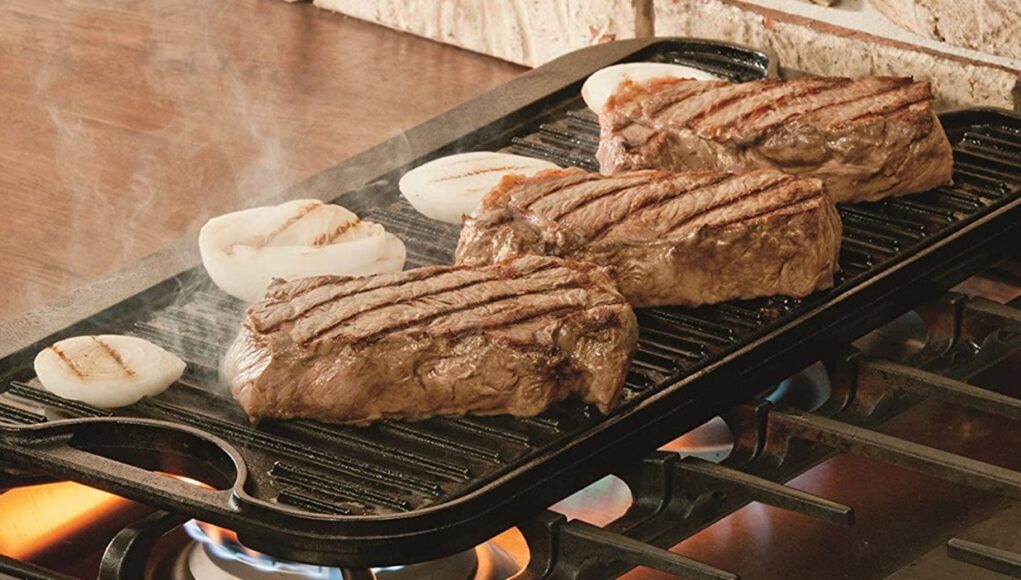When it comes to preparing a griddle for cooking, the choice of oil is crucial. Many home cooks often wonder what oil to season griddle. This crucial step not only enhances the lifespan of the griddle but also the overall cooking experience.
Before diving into the best oils for seasoning, it is important to understand why seasoning is done. Seasoning a griddle creates a non-stick layer that helps protect the surface from rust and makes cooking and cleaning more efficient.

Why Seasoning a Griddle is Crucial
Key Benefits of Proper Seasoning
The process of seasoning involves applying a thin layer of oil to the surface of the griddle and heating it until it forms a polymerized layer. This process provides several benefits:
- Non-stick Surface: Seasoned griddles offer a non-stick surface, making cooking and flipping foods such as pancakes or burgers effortless.
- Rust Prevention: Proper seasoning acts as a protective barrier against moisture, preventing rusting.
- Improved Flavor: Over time, the seasoning layer can enhance the flavor of foods, providing a unique taste.
- Easy Cleaning: A seasoned griddle is easier to clean because food particles are less likely to stick to the surface.
Understanding these benefits highlights the importance of selecting the right oil for seasoning.
Choosing the Appropriate Oil
Choosing the correct oil can be quite challenging, considering the wide range of options available. Some oils are better suited for high-heat applications, while others are more versatile.
Best Oils to Use
Flaxseed Oil
Flaxseed oil is often considered one of the best oils for seasoning due to its high smoke point and ability to polymerize into a hard, durable layer. It forms a solid, long-lasting coating that can withstand regular use.
Canola Oil
Canola oil is a popular choice for its neutral flavor and high smoke point. It’s an affordable and readily available option for most home cooks.
Grapeseed Oil
Grapeseed oil offers a high smoke point and a neutral flavor, making it another excellent option for seasoning a griddle.
Avocado Oil
Avocado oil is praised for its extremely high smoke point, making it suitable for high-heat cooking and seasoning. It has a mild flavor that won’t interfere with the taste of food cooked on the griddle.
Olive Oil
While olive oil has a lower smoke point, it can still be used for seasoning if applied correctly. It imparts a slightly different flavor to the griddle, which some cooks may enjoy.

How to Season a Griddle
Step-by-Step Process for Perfect Seasoning
Understanding how to season a griddle properly is as important as selecting the right oil. Here is a step-by-step guide:
Cleaning the Griddle
Before seasoning, it’s crucial to clean the griddle surface thoroughly to remove any debris or residues.
Applying the Oil
Pour a small amount of your chosen oil onto the griddle and use a paper towel or cloth to spread it evenly across the entire surface.
Heating the Griddle
Heat the griddle to a high temperature to allow the oil to polymerize. This process can be done in several heating cycles to ensure a strong, durable layer.
Cooling and Repeating
Once the oil has darkened and formed a layer, let the griddle cool down. Repeat the process of applying oil and heating several times for best results.
You can find more detailed steps on How to Season a Cast Iron Griddle on our website.
Maintaining Your Seasoned Griddle
Best Practices for Longevity
Once your griddle is seasoned, maintaining it is crucial to ensure its longevity and performance. Here are some tips:
- Regular Cleaning: Clean the griddle after every use with a soft cloth or sponge to maintain the non-stick layer.
- Avoid Soaps: Strong soaps can strip away the seasoning layer. Use mild soap, if necessary.
- Re-seasoning: Periodically re-season the griddle to maintain the protective layer, especially after heavy usage or aggressive cleaning.
- Proper Storage: Store your griddle in a dry place to prevent rust formation.
For more tips on how to maintain your griddle, visit our related articles.
Common Mistakes and How to Avoid Them
Even experienced cooks can make mistakes while seasoning their griddles. Here are some common mistakes and tips to avoid them:
Using the Wrong Oil
Some oils can burn or fail to polymerize properly. Stick to oils with high smoke points, like those recommended earlier.
Applying Too Much Oil
Applying too much oil can result in a sticky surface. Use a thin, even layer for best results.
Not Heating Properly
Ensure the griddle is heated to the right temperature. Inadequate heating can result in incomplete seasoning.
Advanced Seasoning Techniques
Creating a Multi-layered Seasoning
For a more durable non-stick surface, consider creating a multi-layered seasoning. This involves applying and heating multiple thin layers of oil.
Using Seasoning Products
There are specialized products available designed to aid in the seasoning process. These can simplify the process and provide excellent results.
Conclusion
Knowing what oil to season griddle is essential for any home cook. By choosing the right oil and following proper seasoning practices, you can ensure a non-stick, long-lasting griddle surface that enhances your cooking experience.
For more detailed guides on how to grill on a griddle, visit this comprehensive external link.
FAQ Section
What is the best oil for seasoning a griddle?
Flaxseed oil is often considered the best due to its high smoke point and ability to create a hard, durable layer.
Can I use olive oil to season my griddle?
Yes, but keep in mind that olive oil has a lower smoke point. It can still work if applied correctly.
How often should I re-season my griddle?
This depends on usage. Heavy usage or aggressive cleaning may require more frequent re-seasoning.
As an Amazon Associate, I earn from qualifying purchases.









